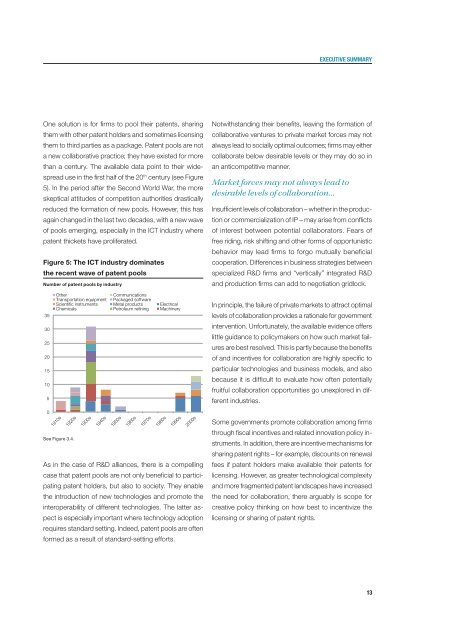World Intellectual Property Report 2011
World Intellectual Property Report 2011
World Intellectual Property Report 2011
Create successful ePaper yourself
Turn your PDF publications into a flip-book with our unique Google optimized e-Paper software.
One solution is for firms to pool their patents, sharing<br />
them with other patent holders and sometimes licensing<br />
them to third parties as a package. Patent pools are not<br />
a new collaborative practice; they have existed for more<br />
than a century. The available data point to their widespread<br />
use in the first half of the 20th century (see Figure<br />
5). In the period after the Second <strong>World</strong> War, the more<br />
skeptical attitudes of competition authorities drastically<br />
reduced the formation of new pools. However, this has<br />
again changed in the last two decades, with a new wave<br />
of pools emerging, especially in the ICT industry where<br />
patent thickets have proliferated.<br />
Figure 5: The ICT industry dominates<br />
the recent wave of patent pools<br />
Number of patent pools by industry<br />
35<br />
30<br />
25<br />
20<br />
15<br />
10<br />
5<br />
0<br />
Other<br />
Communications<br />
Transportation equipment Packaged software<br />
Scienti c instruments Metal products<br />
Chemicals<br />
Petroleum re ning<br />
1910s<br />
1920s<br />
See Figure 3.4.<br />
1930s<br />
1940s<br />
1950s<br />
1960s<br />
1970s<br />
Electrical<br />
Machinery<br />
1980s<br />
1990s<br />
2000s<br />
As in the case of R&D alliances, there is a compelling<br />
case that patent pools are not only beneficial to participating<br />
patent holders, but also to society. They enable<br />
the introduction of new technologies and promote the<br />
interoperability of different technologies. The latter aspect<br />
is especially important where technology adoption<br />
requires standard setting. Indeed, patent pools are often<br />
formed as a result of standard-setting efforts.<br />
Notwithstanding their benefits, leaving the formation of<br />
collaborative ventures to private market forces may not<br />
always lead to socially optimal outcomes; firms may either<br />
collaborate below desirable levels or they may do so in<br />
an anticompetitive manner.<br />
Market forces may not always lead to<br />
desirable levels of collaboration…<br />
Insufficient levels of collaboration – whether in the production<br />
or commercialization of IP – may arise from conflicts<br />
of interest between potential collaborators. Fears of<br />
free riding, risk shifting and other forms of opportunistic<br />
behavior may lead firms to forgo mutually beneficial<br />
cooperation. Differences in business strategies between<br />
specialized R&D firms and “vertically” integrated R&D<br />
and production firms can add to negotiation gridlock.<br />
In principle, the failure of private markets to attract optimal<br />
levels of collaboration provides a rationale for government<br />
intervention. Unfortunately, the available evidence offers<br />
little guidance to policymakers on how such market failures<br />
are best resolved. This is partly because the benefits<br />
of and incentives for collaboration are highly specific to<br />
particular technologies and business models, and also<br />
because it is difficult to evaluate how often potentially<br />
fruitful collaboration opportunities go unexplored in different<br />
industries.<br />
Some governments promote collaboration among firms<br />
through fiscal incentives and related innovation policy in-<br />
struments. In addition, there are incentive mechanisms for<br />
sharing patent rights – for example, discounts on renewal<br />
fees if patent holders make available their patents for<br />
licensing. However, as greater technological complexity<br />
and more fragmented patent landscapes have increased<br />
the need for collaboration, there arguably is scope for<br />
creative policy thinking on how best to incentivize the<br />
licensing or sharing of patent rights.<br />
eXeCUTIVe SUMMArY<br />
13

















